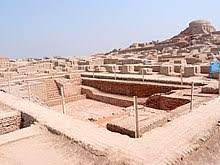- Indus Valley was cradle of early civilization and culture because the place has features which made it conducive for early settlers.
- Rainfall from Indus to Brahmaputra plains gradually increases from 25 cm to 250 cm and this was also the reason that vegetation in low rainfall regions were easier to clear to pave way for the cultivation.
- Indus valley came into being in Indus area, Vedic civilisation in Gangetic plain, Gupta spread further towards east and in medieval periods.
- In 1931, John Marshall estimated the period of Harappa around 3000 years.

Table of Contents
Feature of Indus Valley Civilization
Town Planning: The Harappa civilization has a unique feature of town planning based on the grid system and well defined drainage system connecting each house.
Foreign Trade: The Harappa civilization had trade relation with foreign countries. The seals of Harappa civilization found in Mesopotamia confirm it.
Barter System: Use of metal money was not prevalent in Harappan society. Most probably they carried on all exchanges through barter.
Ornaments: Both men and women wore the ornaments. Agriculture was the main occupation. Fishing was also popular.
Musical Instrument: Flute has been found at the Harappa Site.
Important Sites of Harappa Civilization
Harappa
- This was a rural establishment and Granaries were found.
- The stone symbol of Lingum and yoni, Mother Goddess were found along with mother goddess figure.
- It was located on the river Ravi.
- Graveyard was found here.
Mohan Jodaro
- It was an urban area.
- The great bath was found here.
- Beard priest and burial sites were found at this place.
- Pashupati seal, Statue of a dancing girl were found here.
Dholavira
- Situated in Gujarat, it is famous for unique water reservoir system.
- Located on tropic of Cancer, Horse trade centre, Made of Stones
Lothal
- In Gujarat, famous for dock yard.
- Evidence of Rice, Bead making was an important industry at Lothal.
- In Lothal, three double burials have been found.
Kalibagan
- Bangle factory, multiple crops on the same land, ploughed field were found here.
- It is located in Rajasthan.
Surkotada
Horse bone
Chanhudaro: Only city without citadel, Carts with seated driver. IVC may have been started from here.
Banawali: Oval shaped settlement, only city with radial streets, Toy plough
Mehrgarh: This site is located in a fertile plain, near the Bolan Pass, which is one of the most important routes into Iran. Mehrgarh was probably one of the places where women and men learnt to grow barley and wheat, and rear sheep and goats for the first time in this area. It is one of the earliest villages that we know about.
Several burial sites have been found at Mehrgarh. In one instance, the dead person was buried with goats, which were probably meant to serve as food in the next world.
Cotton was probably grown at Mehrgarh from about 7000 years ago.
While Harappa and Mohenjodaro are situated in Pakistan, the important sites excavated in India are Lothal and Dholavira in Gujarat, Rakhigarhi in Haryana, Ropar in the Punjab, Kalibangan and Balathal in Rajasthan, etc.
Rakhigarhi: Centre is moving ahead with its plan to develop Rakhigarhi as a tourist hub and set up a museum.
As part of encroachment removal at the Rakhigarhi heritage site, 152 households are being shifted to flats.
Citadel: Many of these cities were divided into two or more parts. Usually, the part to the west was smaller but higher. Archaeologists describe this as the citadel. Generally, the part to the east was larger but lower. This is called the lower town. Very often walls of baked brick were built around each part.
The bricks were so well made that they have lasted for thousands of years. The bricks were laid in an interlocking pattern and that made the walls strong.
Cities, such as Kalibangan and Lothal had fire altars, where sacrifices may have been performed. And some cities like Mohenjodaro, Harappa, and Lothal had elaborate store houses.
Important Links